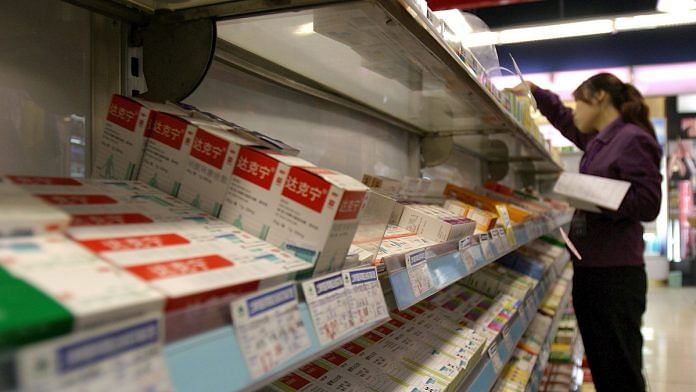New Delhi: The celebrations that followed Beijing’s move to lift import tariffs on Indian medicines are waning. While the Chinese government had assured the Ministry of Commerce and Industry’s pharma exports arm — Pharmaceuticals Export Promotion Council of India (Pharmexcil) — of expediting the approval processes for Indian drug makers, the promise is yet to be realised.
The government has been following up with China’s regulatory agency to understand ‘the proposed regulatory changes’. However, China is still asking India to ‘kindly co-operate’ as the drug regulator has undergone transformation in the past few months.
In July last year, the Chinese government had reached an agreement on reducing tariffs on the import of Indian medicines, particularly anti-cancer drugs, to China. It was seen as an opportunity for Indian companies to enter the lucrative Chinese market.
“China had opened up the market for not only anti-cancer drugs but also for anti-allergic, antibiotics and several other medicines. We will be allowed to export over 130 type drugs to China, once the process of registration and product approvals is completed. But when the process will start and get over is still not clear,” Ravi Uday Bhaskar, director general, Pharmexcil told ThePrint.
Soon after the move, in September, China’s drug regulator, China Food and Drug Administration (CFDA) was turned into the National Medical Products Administration (NMPA). It changed their drug registration and approval system apart from increasing the scope of regulation.
“They are still adapting to the change and are citing the reasons of ‘transformation’ for the delay in processing our requests. They are requesting our co-operation… As of now, there is no addition on our trade with China as a result of the announcement made in July,” Bhaskar said.
According to Pharmexcil, India exports medicines worth $200 million to China as against its $5 billion-drug exports to the United States.
Also read: After goofing up its rare-disease policy, India looks to US, EU, Japan for pointers
Efforts to woo China
India has been lobbying actively with China to ensure easy entry and quick clearances for several years now, but it has not worked.
Soon after the announcement in July, an Indian delegation visited Shanghai for a meeting with Chinese importers on August 20. It included senior officials from the commerce ministry and 27 Indian pharma companies, including Cipla, Natco Pharma, Lupin and Sun Pharma.
Upon visiting the top pharma firms in China, including Fosun Pharma, the delegation understood the requirements of Chinese drug makers.
In August, the commerce ministry also signed a memorandum of understanding with China’s chamber of commerce to speed up the drug approval processes.
In December, the government requested NMPA officials to visit India and address the queries of Indian companies on product registration practices in China.
“The Chinese government officials refused to visit India, citing the hectic schedule due to the ongoing transformation of their organisation,” said another official from Pharmexcil, who was part of the group arranging a workshop on ‘regulatory practices in China and dossier filling with NMPA’.
He added that the government ‘managed to bring’ China’s top pharma company Chinopharma Ltd for the workshop.
Also read: UPA-era generic drug scheme undergoes turnaround, Modi govt to promote it ahead of polls
No change in China’s behaviour
China has been a tough market for Indian drug makers as getting the product registered for export approvals takes around five years as against the three-six months India takes.
“Exemption on duty is not our first priority. A company would be lucky enough if the product gets registered in China in three years. It takes four to five years for our products to get registered in China. In business decisions, these delays cost massive expenditures,” Ashok Madan, executive director, Indian Drug Manufacturers’ Association, a lobby representing over 1,000 pharma companies in India.
“Moreover, the charges are at least five to six times more for product registrations and plant approvals against the charges in India,” Madan added.
Drug makers are exercising caution before they see the final results.
“Opening up of the Chinese drug market is definitely good news but we are waiting for the receipt of early approvals and ease of doing business before we begin celebrations,” said R.C. Juneja, CEO of Mankind Pharma.
India leads the world’s generic drugs market, and exported $17.3 billion-worth (Rs 11,764 crore) drugs in the 2017-18.
The US is the top market for Indian pharma exports. However, entry into China’s market would allow firms to boost revenue at a time when pricing pressures and quality lapses have hurt US sales.




As for China, need for imports will have to be very carefully scrutinised. If & when it becomes necessary, it has to be on reciprocal basis. No preemptive action.
Negotiating with China is effortless. Inter-trade should be very simple. One Re trade for One Re trade.
India should simply require that all trade with China be balanced. Only allow as much imports as exports. And for tariff placed on Indian product, place an equivalent tariff on a Chinese product. And also place a tariff on Chinese content arriving from other countries equal to tariff on that country or content % multipled by 10; which ever is less.